THEME: FANTASY
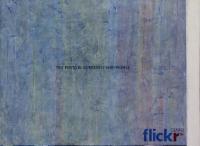 Chen Shijun's distinctive painting style mediates between digital and physical images. The Online Encyclopedia series, for example, takes prosaic images found while browsing online as its source material, and then interprets it through heavy texturing and a nostalgic palette, converting the raw digital image into a final product with an exceptional sense of physicality. Online Encyclopedia: Reality, takes an error message from the website Flickr—a error message reading “This Photo Is Currently Unavailable”—and gives it the texture of a physical artefact. Chen Shijun sources the images in his works from keyword searches on internet search engines, converting the raw image into an oil painting so heavily weathered it seems to bear the mark of time itself.
Chen Shijun's distinctive painting style mediates between digital and physical images. The Online Encyclopedia series, for example, takes prosaic images found while browsing online as its source material, and then interprets it through heavy texturing and a nostalgic palette, converting the raw digital image into a final product with an exceptional sense of physicality. Online Encyclopedia: Reality, takes an error message from the website Flickr—a error message reading “This Photo Is Currently Unavailable”—and gives it the texture of a physical artefact. Chen Shijun sources the images in his works from keyword searches on internet search engines, converting the raw image into an oil painting so heavily weathered it seems to bear the mark of time itself.
Click on the artwork for more information-
$35.00
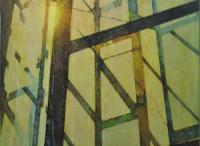 Chen Shijun's distinctive painting style mediates between digital and physical images. The Online Encyclopedia series, for example, takes prosaic images found while browsing online as its source material, and then interprets it through through heavy texturing and a nostalgic palette, converting the raw digital image into a final product with an exceptional sense of physicality. Online Encyclopedia: Daydream, takes an image of late afternoon sun, refracted through a myriad of window panes, as its subject. The painting has a dreamy, nostalgic effect, the sunlight lost in plays of light and shadow just as the mind escapes into absent-minded thought.
Chen Shijun's distinctive painting style mediates between digital and physical images. The Online Encyclopedia series, for example, takes prosaic images found while browsing online as its source material, and then interprets it through through heavy texturing and a nostalgic palette, converting the raw digital image into a final product with an exceptional sense of physicality. Online Encyclopedia: Daydream, takes an image of late afternoon sun, refracted through a myriad of window panes, as its subject. The painting has a dreamy, nostalgic effect, the sunlight lost in plays of light and shadow just as the mind escapes into absent-minded thought.
Click on the artwork for more information-
$35.00
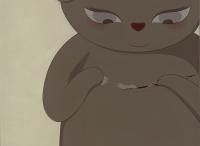 As the title of the work implies, this teddy bear with a heart-shaped nose and a coy smile appears to be quite peaceful. Upon closer examination, however, a more sinister and disturbing scene unfolds before us. We quickly discover that this cuddly creature is in the midst of pulling the stuffing from its chest. Even more unsettling is the apparent relish with which this act is being undertaken. The bear's focused gaze, rosy cheeks and sly grin all illustrate a degree of amusement. An additional level of tension and disquiet is achieved with the subtle drops of ruby red along the mouth and dotting its paws. This detail further emphasizes the surreal elements of the composition, as this seemingly living, breathing stuffed bear blushes with pleasure.
As the title of the work implies, this teddy bear with a heart-shaped nose and a coy smile appears to be quite peaceful. Upon closer examination, however, a more sinister and disturbing scene unfolds before us. We quickly discover that this cuddly creature is in the midst of pulling the stuffing from its chest. Even more unsettling is the apparent relish with which this act is being undertaken. The bear's focused gaze, rosy cheeks and sly grin all illustrate a degree of amusement. An additional level of tension and disquiet is achieved with the subtle drops of ruby red along the mouth and dotting its paws. This detail further emphasizes the surreal elements of the composition, as this seemingly living, breathing stuffed bear blushes with pleasure.
Click on the artwork for more information-
$35.00
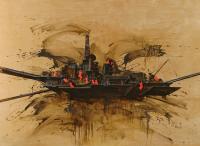 Zhu Zhiwei’s paintings dwell on the incredible scale of China’s industrialization, and the relationship between modern city-dwellers and the man-made environment that they inhabit. Modern Behemoth No. 1 depicts a multi-tiered, abstracted mass of blackened machinery and its twelve orange inhabitants. The wild brushstrokes that surround this structure convey a sense of wild motion and instability, which is reinforced by the viewer’s low vantage point and the cable swinging from the crane on the right. The dripping streams of black paint give a feeling of gravity and oily grime.
Zhu Zhiwei’s paintings dwell on the incredible scale of China’s industrialization, and the relationship between modern city-dwellers and the man-made environment that they inhabit. Modern Behemoth No. 1 depicts a multi-tiered, abstracted mass of blackened machinery and its twelve orange inhabitants. The wild brushstrokes that surround this structure convey a sense of wild motion and instability, which is reinforced by the viewer’s low vantage point and the cable swinging from the crane on the right. The dripping streams of black paint give a feeling of gravity and oily grime.
The twelve cartoonish characters are disproportionately large compared to the cranes and superstructure, but their oversize heads give them an infant-like appearance. They frolic about, while some vandalize machinery with glee. They appear to be unaware of the precarious state of the platform, much less its original purpose. The overall impression is that of an unsupervised industrial playground hurtling wildly through space.
Click on the artwork for more information-
$59.00
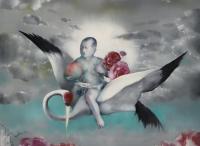 Luo Fahui is part of the generation of artists who studied fine arts shortly after the Cultural Revolution (1966-1976). His oil paintings, which are characterized by surreal, pearly gray compositions, punctuated by bright splashes of crimson and turquoise, address themes of desire, isolation and violence.
Luo Fahui is part of the generation of artists who studied fine arts shortly after the Cultural Revolution (1966-1976). His oil paintings, which are characterized by surreal, pearly gray compositions, punctuated by bright splashes of crimson and turquoise, address themes of desire, isolation and violence.
The title of this work refers to ancient poems of mystical excursion, in which a Daoist master is carried off to the realm of the Immortals. These stories were sometimes fantasies of poets who dreamt of escaping conventional society. In Chinese mythology, the Immortals’ preferred mode of transportation was a fantastical red-crowned crane; mortals who achieved immortality were similarly carried off by one of these creatures. The Immortals prized rare magical peaches, which conferred 1000 years of life on those who consumed them.
In Mystical Journey, the artist has added a slew of roses, which in Luo’s work are frequently associated with desire and lust. The Daoist master has been replaced with a large fleshy boy, possibly the artist’s alter-ego. The crane hovers indecisively between an inviting bed of lush blossoms below and the glowing heavens above. The child bears a peach of immortality in one arm and more roses in the other. It appears that some difficult choices will have to be made if the journey to transcendence is to be completed.
Click on the artwork for more information-
$35.00
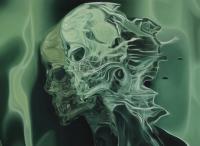 2008.11 depicts an overlapping pair of spectral skulls. It is part of larger series based inspired by the Zheng’s reflections on death. The skulls are shown in profile with their deep, disproportionately large eye sockets facing the to the left. Zheng’s undulating brushwork creates a powerful impression of energy and and motion, complicating subjects’ usual association with mortality. The painting’s monochrome green palette blurs the distinction between the skulls and the background – it is not clear if we are looking at the skulls themselves, or only the ripples in the electrified atmosphere as they fly past us. While their facial outlines are nearly identical, their states of existence appear quite different. In the background, the larger cranium appears static and dark, possibly fading with the passage of time. In contrast, the skull in the foreground is luminous and dynamic; apparently leaving a wake of sparkling, swirling green energy. Is this a portrait of companionship, a progression from past to present, or a contrast of physical and spiritual? The effect is similar to a doubly exposed negative; the two images intimate a photographic progression. This suspension in space and time has made an object of movement itself, leaving its viewers to contemplate the relationship between permanence and transience.
2008.11 depicts an overlapping pair of spectral skulls. It is part of larger series based inspired by the Zheng’s reflections on death. The skulls are shown in profile with their deep, disproportionately large eye sockets facing the to the left. Zheng’s undulating brushwork creates a powerful impression of energy and and motion, complicating subjects’ usual association with mortality. The painting’s monochrome green palette blurs the distinction between the skulls and the background – it is not clear if we are looking at the skulls themselves, or only the ripples in the electrified atmosphere as they fly past us. While their facial outlines are nearly identical, their states of existence appear quite different. In the background, the larger cranium appears static and dark, possibly fading with the passage of time. In contrast, the skull in the foreground is luminous and dynamic; apparently leaving a wake of sparkling, swirling green energy. Is this a portrait of companionship, a progression from past to present, or a contrast of physical and spiritual? The effect is similar to a doubly exposed negative; the two images intimate a photographic progression. This suspension in space and time has made an object of movement itself, leaving its viewers to contemplate the relationship between permanence and transience.
Click on the artwork for more information-
$35.00
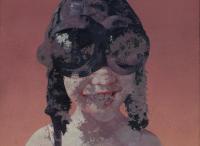 A toothy grin and great googly eyes. A child smiles at you, and the aviator's cap on her head is both absurd and whimsical, a joke the child knowingly shares with you the observer. Children are a frequent theme in Guo Jin's work, meditations upon pure joy and unadultered idealism. But against the context of modern China, the commentary takes on deeper, critical tones, asking if society's innocence has been lost or if naivety remains; if our worldview is youthful with its eyes full of opportunity, or blinded and obscurded by play-acting and make-believe.
A toothy grin and great googly eyes. A child smiles at you, and the aviator's cap on her head is both absurd and whimsical, a joke the child knowingly shares with you the observer. Children are a frequent theme in Guo Jin's work, meditations upon pure joy and unadultered idealism. But against the context of modern China, the commentary takes on deeper, critical tones, asking if society's innocence has been lost or if naivety remains; if our worldview is youthful with its eyes full of opportunity, or blinded and obscurded by play-acting and make-believe.
Click on the artwork for more information-
$35.00
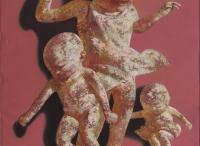 Children are a frequent theme in Guo Jin's work, meditations upon pure joy and unadultered idealism. Jumping catches three children at Henri Cartier-Bresson's “decisive moment,” poised in kinetic potential as they jump mid-air against an abstract pink sky. Their rounded bodies possess a convincing heft, but their skin is spackled in red, yellow, peach, and white, a texture that suggests both materiality, like the surface of marble, and the passage of time, like antiqued painted furniture. Are these children real or allegorical? Where are they leaping to and what are they leaping from? Guo Jin's work gives itself to many different readings, but the children's sense of dynamism and joy remains constant.
Children are a frequent theme in Guo Jin's work, meditations upon pure joy and unadultered idealism. Jumping catches three children at Henri Cartier-Bresson's “decisive moment,” poised in kinetic potential as they jump mid-air against an abstract pink sky. Their rounded bodies possess a convincing heft, but their skin is spackled in red, yellow, peach, and white, a texture that suggests both materiality, like the surface of marble, and the passage of time, like antiqued painted furniture. Are these children real or allegorical? Where are they leaping to and what are they leaping from? Guo Jin's work gives itself to many different readings, but the children's sense of dynamism and joy remains constant.
Click on the artwork for more information-
$35.00
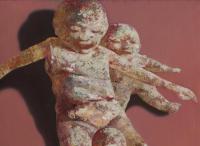 Children are a frequent theme in Guo Jin's work, meditations upon pure joy and unadultered idealism. Sliding captures a group of three moving with grace and abandon down an unseen slide behind them. Their movement is innocent, capturing a moment of play, but when the children are considered as stand-ins for something greater, whether that be society or the state of a country, the painting takes on greater complexities: does the downward slide imply loss or danger, and if so, what is the childrens' agency? Did they initate this descent, or plunge into it unwittingly? Guo Jin's work gives itself to many different readings, but the painting's sense of momentum and unknown potential remains constant.
Children are a frequent theme in Guo Jin's work, meditations upon pure joy and unadultered idealism. Sliding captures a group of three moving with grace and abandon down an unseen slide behind them. Their movement is innocent, capturing a moment of play, but when the children are considered as stand-ins for something greater, whether that be society or the state of a country, the painting takes on greater complexities: does the downward slide imply loss or danger, and if so, what is the childrens' agency? Did they initate this descent, or plunge into it unwittingly? Guo Jin's work gives itself to many different readings, but the painting's sense of momentum and unknown potential remains constant.
Click on the artwork for more information-
$35.00
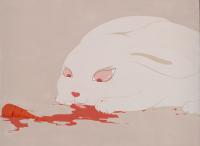 The scene is a gruesome one; a vicious creature with demonic red eyes and sharp claws eagerly laps at a gradually spreading pool of blood. Our gaze follows the trail of blood to the mangled corpse of a poor, defenseless carrot. Breathing a sigh of relief, the viewer quickly realizes that what was initially mistaken for blood is merely carrot juice and the bloodthirsty beast is just an albino bunny innocently enjoying its favorite snack. This mischievous visual duplicity typifies Lili's style and tiptoes playfully on the edge between lighthearted humor and foreboding dread. Her simultaneously cute and creepy animal subjects leave us questioning the difference and relationship between these two extremes.
The scene is a gruesome one; a vicious creature with demonic red eyes and sharp claws eagerly laps at a gradually spreading pool of blood. Our gaze follows the trail of blood to the mangled corpse of a poor, defenseless carrot. Breathing a sigh of relief, the viewer quickly realizes that what was initially mistaken for blood is merely carrot juice and the bloodthirsty beast is just an albino bunny innocently enjoying its favorite snack. This mischievous visual duplicity typifies Lili's style and tiptoes playfully on the edge between lighthearted humor and foreboding dread. Her simultaneously cute and creepy animal subjects leave us questioning the difference and relationship between these two extremes.
Click on the artwork for more information-
$35.00
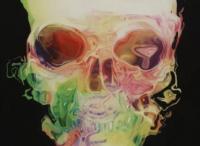 2009-07, is part of larger series based inspired by the the artist’s reflections on death. a large skull is centered on a black background. It is rendered frontally in a shimmering riot of colors, which gives it a psychedelic flavor. Despite its eerie qualities, its atypical, abstracted representation partially removes its deathly associations; the skull’s technicolor, viscous rendering dissolves its outline, which helps to conceal its true nature. However, its deep eye sockets create a vacuum that draws in its viewers, forcing them into a staring match that they cannot hope to win. This frontal depiction is a watery mirror for its audience, and a less than subtle reminder of the inevitability of mortality.
2009-07, is part of larger series based inspired by the the artist’s reflections on death. a large skull is centered on a black background. It is rendered frontally in a shimmering riot of colors, which gives it a psychedelic flavor. Despite its eerie qualities, its atypical, abstracted representation partially removes its deathly associations; the skull’s technicolor, viscous rendering dissolves its outline, which helps to conceal its true nature. However, its deep eye sockets create a vacuum that draws in its viewers, forcing them into a staring match that they cannot hope to win. This frontal depiction is a watery mirror for its audience, and a less than subtle reminder of the inevitability of mortality.
Click on the artwork for more information-
$35.00








